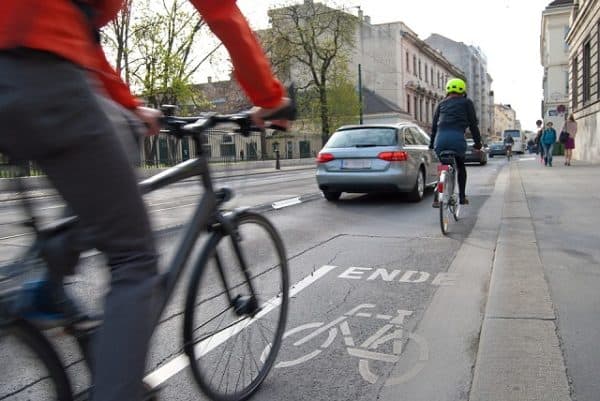

A new traffic safety study has found that when it comes to the spacing between cars and bicycles, lane width, speed and traffic density can all negatively impact passing distance and thus cyclists’ comfort level with sharing the road.
The hazards of bike riding in the city are well known. Each year across Canada, about 7,500 cyclists are seriously injured on the road. And fatal collisions between cars and bicycles have not decreased significantly over the past two decades, even as cities strive to make their streets more amenable to bike traffic by putting in measures such as dedicated bike lanes and signage.
Of all the deterrents to getting people on their bikes (something all municipalities are calling for), the perception of safety and comfort is number one. Yet, putting in bike lanes and painting sharrows onto streets (those double arrows that call for cars to share the lane) can only do so much, especially since in reality, most bike trips take cyclists outside of dedicated lanes for some portion of travel. Biking on mixed traffic streets is thus an inevitability, as are its dangers.
“Passing is one inevitable event in mixed traffic, hence passing distance is very significant in bicycle and motor vehicle interaction,” say the study’s authors, researchers with the Department of Civil and Environmental Engineering at Carleton University in Ottawa.
To that end, the researchers studied the passing distance between cars and bicycles on six streets in Ottawa and gauged how factors such as vehicle and bicycle speed, traffic density and lane width affect passing distance. Video data was collected at the sites during peak traffic hours, producing a total of 563 passing events, which were then analyzed to determine passing distances and other features.
The study found that overall, 90 per cent of passes exceeded 1.23 metres, which is more than the standard regulated for most Canadian regions of one metre in urban areas. And while passing distances were found to be greater when motor vehicle speeds were higher and street lanes were wider, the distance got narrower when the traffic density was high or when the cyclist’s speed was higher.
The study’s authors also found that while the average distance between bicycles and the curb was 0.57 m, the distance between bicycles and parked cars was significantly less at 0.35 m, meaning that cyclists are having to face the added danger of “dooring” crashes.
“The observation across all variables shows an overwhelming compliance of drivers in Ottawa to the 1 m spacing requirement,” say the study’s authors. “Many bicyclists ride within the dooring zone regardless of the road width, and it is worse on narrower lanes.”
The researchers suggest that for roads with lanes narrower than 3.6 m, sharrows and road signage warning against dooring be used and that for wider roads where car traffic speeds tend to go up, speed calming measures be put in place.
“All these treatments are expected to help draw the bicyclist out of the hazard zone and make them more visible to drivers,” say the authors.
The new study is published in the journal Accident Analysis & Prevention.
Leave a Reply
You must be logged in to post a comment.



 Share
Share Tweet
Tweet Share
Share




Comment